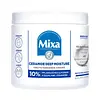What's inside
What's inside
 Key Ingredients
Key Ingredients

 Benefits
Benefits

 Concerns
Concerns

 Ingredients Side-by-side
Ingredients Side-by-side

Water
Skin ConditioningGlycerin
HumectantButyrospermum Parkii Butter
Skin ConditioningIsopropyl Palmitate
EmollientPropanediol
SolventCetyl Alcohol
EmollientMyristyl Myristate
EmollientZea Mays Starch
AbsorbentSqualane
EmollientCarbomer
Emulsion StabilisingSodium Hydroxide
Buffering2-Oleamido-1,3-Octadecanediol
Skin ConditioningHydroxyacetophenone
AntioxidantHydroxypalmitoyl Sphinganine
Skin ConditioningCaprylyl Glycol
EmollientCitric Acid
BufferingPolyglyceryl-3 Methylglucose Distearate
EmulsifyingTocopherol
AntioxidantWater, Glycerin, Butyrospermum Parkii Butter, Isopropyl Palmitate, Propanediol, Cetyl Alcohol, Myristyl Myristate, Zea Mays Starch, Squalane, Carbomer, Sodium Hydroxide, 2-Oleamido-1,3-Octadecanediol, Hydroxyacetophenone, Hydroxypalmitoyl Sphinganine, Caprylyl Glycol, Citric Acid, Polyglyceryl-3 Methylglucose Distearate, Tocopherol
Water
Skin ConditioningGlycerin
HumectantPetrolatum
EmollientParaffinum Liquidum
EmollientNiacinamide
SmoothingGlyceryl Stearate
EmollientCetyl Alcohol
EmollientPEG-40 Stearate
EmulsifyingButyrospermum Parkii Butter
Skin ConditioningCetyl Palmitate
EmollientDimethicone
EmollientAscorbyl Palmitate
AntioxidantChlorhexidine Digluconate
AntimicrobialCitric Acid
BufferingCoriandrum Sativum Seed Oil
EmollientEchium Plantagineum Seed Oil
Skin ConditioningGlycine Soja Oil
EmollientPanthenol
Skin ConditioningPrunus Armeniaca Kernel Oil
MaskingRibes Nigrum Seed Oil
EmollientSorbitan Tristearate
EmulsifyingTocopherol
AntioxidantWater, Glycerin, Petrolatum, Paraffinum Liquidum, Niacinamide, Glyceryl Stearate, Cetyl Alcohol, PEG-40 Stearate, Butyrospermum Parkii Butter, Cetyl Palmitate, Dimethicone, Ascorbyl Palmitate, Chlorhexidine Digluconate, Citric Acid, Coriandrum Sativum Seed Oil, Echium Plantagineum Seed Oil, Glycine Soja Oil, Panthenol, Prunus Armeniaca Kernel Oil, Ribes Nigrum Seed Oil, Sorbitan Tristearate, Tocopherol
Ingredients Explained
These ingredients are found in both products.
Ingredients higher up in an ingredient list are typically present in a larger amount.
This ingredient is also known as shea butter. It is an effective skin hydrator and emollient.
Emollients help soothe and soften your skin. It does this by creating a protective film on your skin. This barrier helps trap moisture and keeps your skin hydrated. Emollients may be effective at treating dry or itchy skin.
Shea butter is rich in antioxidants. Antioxidants help fight free-radicals, or molecules that may harm the body. It is also full of fatty acids including stearic acid and linoleic acid. These acids help replenish the skin and keep skin moisturized.
While Shea Butter has an SPF rating of about 3-4, it is not a sunscreen replacement.
Shea butter may not be fungal acne safe. We recommend speaking with a professional if you have any concerns.
Learn more about Butyrospermum Parkii ButterCetyl Alcohol is a fatty alcohol. Fatty Alcohols are most often used as an emollient or to thicken a product.
Its main roles are:
Though it has "alcohol" in the name, it is not related to denatured alcohol or ethyl alcohol.
The FDA allows products labeled "alcohol-free" to have fatty alcohols.
Learn more about Cetyl AlcoholCitric Acid is an alpha hydroxy acid (AHA) naturally found in citrus fruits like oranges, lemons, and limes.
Like other AHAs, citric acid can exfoliate skin by breaking down the bonds that hold dead skin cells together. This helps reveal smoother and brighter skin underneath.
However, this exfoliating effect only happens at high concentrations (20%) which can be hard to find in cosmetic products.
Due to this, citric acid is usually included in small amounts as a pH adjuster. This helps keep products slightly more acidic and compatible with skin's natural pH.
In skincare formulas, citric acid can:
While it can provide some skin benefits, research shows lactic acid and glycolic acid are generally more effective and less irritating exfoliants.
Most citric acid used in skincare today is made by fermenting sugars (usually from molasses). This synthetic version is identical to the natural citrus form but easier to stabilize and use in formulations.
Read more about some other popular AHA's here:
Learn more about Citric AcidGlycerin is already naturally found in your skin. It helps moisturize and protect your skin.
A study from 2016 found glycerin to be more effective as a humectant than AHAs and hyaluronic acid.
As a humectant, it helps the skin stay hydrated by pulling moisture to your skin. The low molecular weight of glycerin allows it to pull moisture into the deeper layers of your skin.
Hydrated skin improves your skin barrier; Your skin barrier helps protect against irritants and bacteria.
Glycerin has also been found to have antimicrobial and antiviral properties. Due to these properties, glycerin is often used in wound and burn treatments.
In cosmetics, glycerin is usually derived from plants such as soybean or palm. However, it can also be sourced from animals, such as tallow or animal fat.
This ingredient is organic, colorless, odorless, and non-toxic.
Glycerin is the name for this ingredient in American English. British English uses Glycerol/Glycerine.
Learn more about GlycerinTocopherol (also known as Vitamin E) is a common antioxidant used to help protect the skin from free-radicals and strengthen the skin barrier. It's also fat soluble - this means our skin is great at absorbing it.
Vitamin E also helps keep your natural skin lipids healthy. Your lipid skin barrier naturally consists of lipids, ceramides, and fatty acids. Vitamin E offers extra protection for your skin’s lipid barrier, keeping your skin healthy and nourished.
Another benefit is a bit of UV protection. Vitamin E helps reduce the damage caused by UVB rays. (It should not replace your sunscreen). Combining it with Vitamin C can decrease sunburned cells and hyperpigmentation after UV exposure.
You might have noticed Vitamin E + C often paired together. This is because it is great at stabilizing Vitamin C. Using the two together helps increase the effectiveness of both ingredients.
There are often claims that Vitamin E can reduce/prevent scarring, but these claims haven't been confirmed by scientific research.
Learn more about TocopherolWater. It's the most common cosmetic ingredient of all. You'll usually see it at the top of ingredient lists, meaning that it makes up the largest part of the product.
So why is it so popular? Water most often acts as a solvent - this means that it helps dissolve other ingredients into the formulation.
You'll also recognize water as that liquid we all need to stay alive. If you see this, drink a glass of water. Stay hydrated!
Learn more about Water